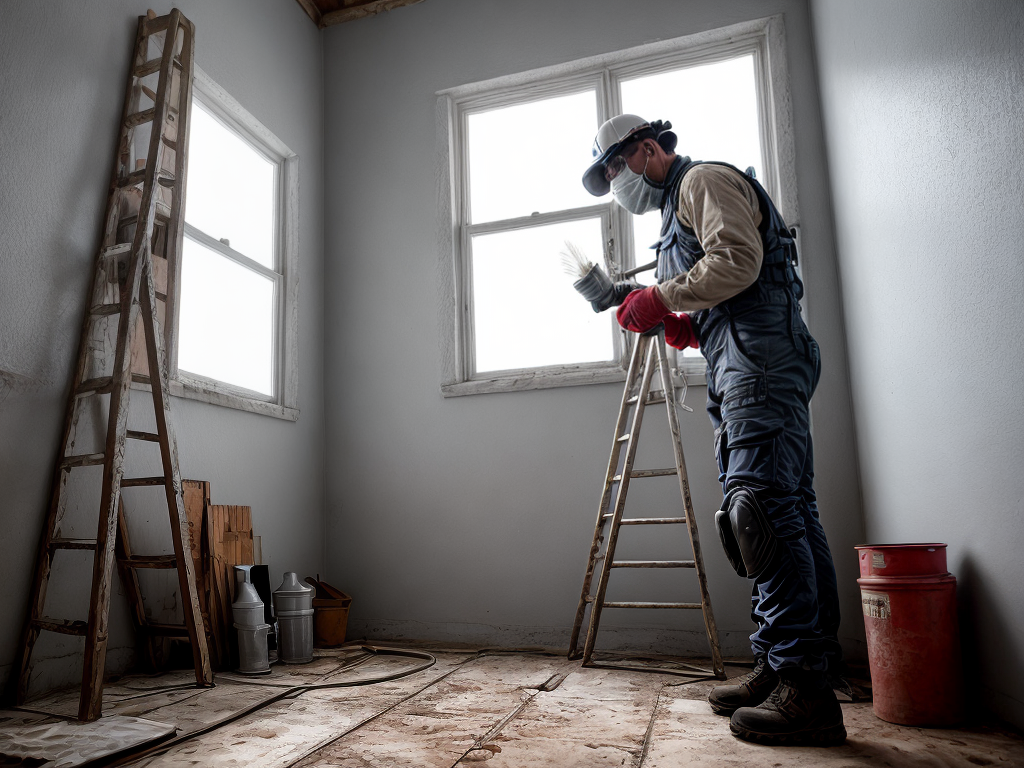
I’m a professional painter and I’ve seen my fair share of accidents. Safety should always be a priority, whether you’re a pro or a DIY enthusiast. That’s why I’ve put together this guide on the top 7 safety measures for interior and exterior painting. I’ll cover everything from understanding paint materials to emergency response preparation. So, let’s dive in and make sure your next painting project is a safe one!
Understanding Paint Materials Safety
In the realm of painting, I must understand the safety aspects of the materials I’m using. My experience has taught me to never underestimate the risks associated with paint allergies. Some individuals might develop allergic reactions to certain paints, which can result in rashes, itchiness, or even respiratory issues.
I’ve also learned the importance of proper material disposal. Leftover paint and other materials can’t just be tossed in the trash or poured down the drain. They can pose environmental threats and even legal issues. That’s why I always make sure to dispose of my painting materials properly, following local regulations. It’s not just about creating a beautiful piece of art, it’s also about ensuring safety and responsibility throughout the process.
Importance of Proper Ventilation
Moving on to another crucial point, I can’t stress enough the importance of setting up proper ventilation when it comes to both interior and exterior painting projects. The use of ventilation equipment is vital to ensure good indoor air quality.
During painting, volatile organic compounds (VOCs) are released, which can cause headaches, dizziness, and other symptoms if inhaled. Proper ventilation helps disperse these harmful substances, improving the indoor air quality and creating a safer environment.
When painting outdoors, it’s easy to overlook ventilation, but it’s still necessary. Wind can carry paint particles and dust, which could be harmful if inhaled. Ventilation equipment like fans can help direct these away from the workspace. So, don’t underestimate its importance.
Safeguarding Skin and Eyes
For my next safety tip, I can’t stress enough how important it is to protect your skin and eyes when painting. The use of Personal Protective Equipment (PPE) is essential. I always make sure to wear gloves to protect my hands from direct contact with paint and chemicals. I also use safety goggles to protect my eyes from splashes or drips. In addition to PPE, it’s vital to adopt Safe Cleanup Methods. When I’m done painting, I carefully remove my gloves and goggles, avoiding any contact with my skin. I then wash my hands and face thoroughly with soap and water. By taking these steps, I ensure that I’m not only producing a great paint job but also prioritizing my health.
Utilizing Safe Ladder Practices
Following the vein of safety precautions, another critical aspect I always pay attention to is utilizing safe ladder practices while painting. This helps with fall prevention and ensures a secure work environment.
- Ladder positioning: I make sure the ladder is positioned on a stable, level surface. If it’s leaning against a wall, I follow the ‘4-to-1’ rule: for every four feet of height, the base should be one foot away from the wall.
- Inspection: I always inspect the ladder before use. I’m checking for any defects or damage that could affect its stability.
- Fall prevention: I don’t overreach when painting. Instead, I descend and move the ladder to prevent falls. Using a ladder with a platform for paint and tools also helps in maintaining balance.
Safe ladder practices are vital. I can’t stress enough their importance in preventing accidents while painting.
Handling Paint Removal Safely
I’m always cautious when it comes to paint removal, ensuring safety measures are strictly adhered to. Wearing protective clothing is a must, right from gloves to safety goggles and a mask. It’s also crucial to follow disposal guidelines to the letter, ensuring waste doesn’t harm the environment.
Here’s a table summarizing key points:
| Safety Measures | Description |
|---|---|
| Protective Clothing | Wear gloves, safety goggles, and a mask to protect yourself |
| Ventilation | Ensure the area is well-ventilated to avoid inhaling toxic fumes |
| Disposal Guidelines | Follow local guidelines for disposing of paint waste |
Safe Storage of Painting Supplies
So, how should you safely store your painting supplies after ensuring a secure paint removal process? Here’s where supply organization and proper disposal methods come into play.
- Supply Organization: Keep your painting supplies in a cool, dry place, away from heat sources. Use a well-organized storage system, such as labeled bins.
- Proper Disposal: Don’t just toss leftover paint or solvents! Check your local regulations for safe disposal methods.
- Secure Packaging: Ensure all containers are tightly sealed to prevent spills and fumes.
Emergency Response Preparation
In my experience, it’s essential to be prepared for emergencies when undertaking any painting job, whether interior or exterior. This not only involves having a well-stocked first aid kit on hand but also knowing the first aid basics. It’s critical to know how to handle common injuries like cuts, scrapes or falls from a ladder.
Conducting emergency drills regularly is another key aspect of preparation. These drills ensure everyone on the team knows exactly what to do in case of an accident. From minor incidents like paint spills to major ones like a fire, being prepared can make a significant difference. Remember, safety should always be your top priority when painting.


